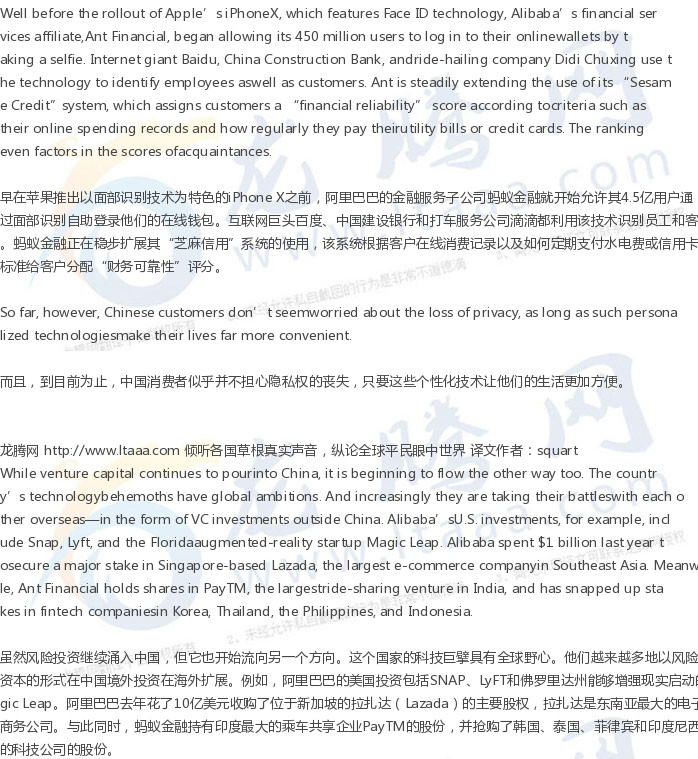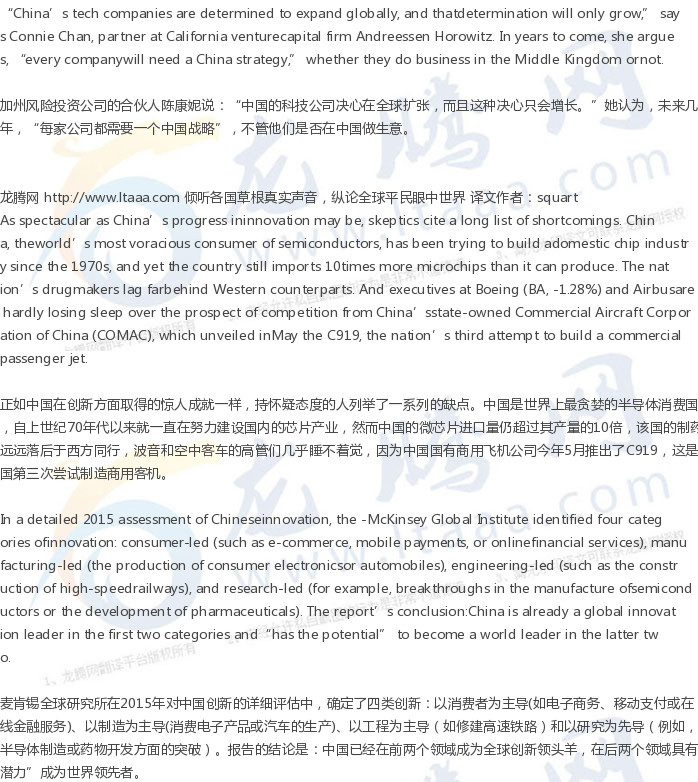中国正在崛起成为与美国匹敌的超级科技大国 [美国媒体]
无人机世界的狗斗比赛就要开始了。2016年11月,大疆创新科技公司,也就是众所周知的DJI,正准备推出它的杀手级新产品:Mavic Pro。Mavic的重量只有1.6磅,足够小巧,可以装进书包里,并且具有4英里的飞行距离以及内置摄像头,能够从几百英尺高处拍摄4K分辨率的视频......
A dogfight in the world of drones was aboutto begin. It was November 2016, and Da-Jiang Innovations Science andTechnology, better known as DJI, was preparing to launch its killer newproduct: the Mavic Pro. Weighing just 1.6 pounds, the Mavic was compact enoughto fit into a book bag and featured a four-mile flight range and a built-incamera capable of shooting pin-sharp 4K video from hundreds of feet up. Thoughpriced below $1,000, the Mavic sported sophisticated gimbals to stabilize thecamera and cutting-edge software enabling it to lock on subjects and followthem around, detect and avoid midair obstacles, and automatically return to itslaunch point before running out of power.
无人机世界的狗斗比赛就要开始了。2016年11月,大疆创新科技公司,也就是众所周知的DJI,正准备推出它的杀手级新产品:Mavic Pro。Mavic的重量只有1.6磅,足够小巧,可以装进书包里,并且具有4英里的飞行距离以及内置摄像头,能够从几百英尺高处拍摄4K分辨率的视频。虽然它的价格低于1000美元,但Mavic先进的运动方向感控软件可以用来稳定相机,使其能够锁定和跟踪对象,侦测和躲避空中飞行时的障碍,并在电力耗尽前自动回到起飞点。
Meanwhile, the drone contenders from theWest fell back to earth one by one. Parrot was the first to surrender,announcing in January it was axing workers from its drone division. Then Lilyrevealed that, despite collecting more than $34 million in preorders, it hadburned through all its cash and would close without shipping a single unit. Thereal surprise was GoPro. The San Mateo, Calif., company had established itsbrand by selling more than 20 million “wearable” cameras. And CEO Nick Woodmanhad vowed GoPro would return to profitability with the release of a heavilymarketed drone called Karma. But the Karma, it turns out, was bad—heavier andslower than its Chinese rival, and lacking its tracking or detect-and-avoidcapabilities. Worse, the first Karmas had an alarming tendency to lose powerand drop from the sky. After an embarrassing recall, GoPro relaunched inFebruary. By then, DJI had taken off.
与此同时,西方的无人机竞争者一个接一个地跌倒。Parrot是第一个投降的人,他于一月宣布它正从无人机部门中裁员。随后是百合公司,尽管预付款超过了3400万美元,但百合已经耗尽了所有现金,公司将被关闭,而且公司连一个成品都没有生产出来。真正的惊喜是Gopro。这个公司建立了自己的品牌并生产销售了超过2000万的“可穿戴式”相机,其首席执行官尼克•伍德曼誓言要让GOPro重返盈利,并将发布一个代号“卡马”的无人机。但是,随即的证明表示,卡吗比它的中国竞争对手更重、更慢,而且缺乏跟踪、检测和避免的能力。更糟糕的是,卡吗有一个惊人的bug,会突然失去动力从天上掉下来。在这次尴尬的亮相之后,Gopro在二月份重新起航。但是这个时候,DJI早已经发展起来了。
Fast-forward to today, and DJI controlsmore than 70% of the commercial drone market, a category that could soar to $15billion by 2022, according to global research firm Interact Analysis, up from$1.3 billion last year. With venture funding from Accel Partners and SequoiaCapital, DJI has a valuation of $10 billion. The company doesn’t disclosefinancial results, but it has been widely estimated by analysts that sales thisyear will exceed $1.5 billion, with earnings approaching $500 million.
到了今天,DJI控制着商业无人机市场的70%以上,根据全球研究公司交互分析的数据,到2022年,DJI的营收可能飙升至150亿美元,远远高于去年的13亿美元。凭借Accel合伙公司和红杉资本的风险投资,DJI的估值超过100亿美元,该公司没有公布财务报表,但分析师普遍估计,今年公司的销售额将超过15亿美元,利润接近5亿美元。
Business in China today, however, is beingled by innovation-obsessed execs like Ren Zhengfei, founder of HuaweiTechnologies, which last year filed more patent applications than any othercompany in the world. And Allen Zhang, who led the team that developedTencent’s WeChat, the smartphone app that allows its 900 million users to chat,shop, pay, play, and do just about anything else. And Robin Li, CEO of Baidu,the Beijing-based search company, who has vowed to have autonomous vehiclesready for sale in China by next year.
然而,如今中国的商业正由热衷于创新的高管领导,比如华为科技的创始人任正非,华为去年提交的专利申请比世界上任何一家公司都要多。还有张小龙,他领导的团队开发了腾讯的微信,这个智能手机应用程序允许其9亿用户聊天、购物、付费、玩耍,以及做其他事情。北京的搜索公司百度的首席执行官李彦宏也宣称,将在明年之前在中国销售自动驾驶汽车。
Their success is fueling a virtuous cycleof innovative activity. The country’s two largest Internet companies, AlibabaGroup (BABA, +1.59%) and Tencent Holdings (TCEHY, -1.05%), lead the world in e-commerce,mobile payments, social media, and online gaming. They and other Chinese techgiants are investing aggressively in new businesses, helping to transform Chinainto a massive market for venture capital investments. Those ventures, in turn,are nourished by China’s huge and growing market and its unique ecosystem ofsuppliers, logistics specialists, and manufacturers. The result: China hasspawned a new generation of homegrown entrepreneurs who are creatingworld-class products, developing their own technologies, and rolling out newbusiness models on a scale and with a speed the global economy has never seen.“The copycat era is behind us,” says Kai-Fu Lee, CEO of Sinovation Ventures andthe former head of Google China. “We are way beyond that.”
他们的成功推动了创新活动的良性循环。中国最大的两家互联网公司,阿里巴巴集团和腾讯控股,在电子商务、移动支付、社交媒体和网络游戏方面领先于世界。他们和其他中国科技巨头正在积极地投资新业务,帮助中国转变为风险资本投资的巨大市场。这些企业反过来又被中国庞大而不断增长的市场和其独特的供应商、物流和制造商的生态系统所滋养。结果就是:中国催生了新一代的本土企业家,他们正在创造世界级的产品,开发自己的技术,并以全球经济从未有过的速度大规模推出新的商业模式。“模仿时代已经过去了,”中国华正创业投资有限公司首席执行官李开复,也是谷歌中国的前负责人说:“我们远远超过了这一步。”
China’s rising class of innovators benefitsfrom several built-in advantages. One is the vast scale of China’s market,which drives powerful efficiencies as new products and services are rolled outto hundreds of millions of people. Another is that Chinese consumers areenthusiastic adapters of new technologies, and that entrepreneurs operate in adeveloping market unencumbered by legacy infrastructure. China’s shoppers havetaken quickly to online shopping and digital payments in part because theydidn’t have to unlearn habits of shopping at traditional brick-and-mortarstores.
中国崛起的创新者得益于一些内在的优势。一是中国市场的巨大规模,随着新产品和服务向亿万人民的推出,这极大地提高了效率。另一个原因是,中国消费者对新技术非常热心,而且企业家在不受传统基础设施影响的发展中市场开展业务。中国的购物者迅速转向网上购物和数字支付,部分原因是他们不必忘记在传统实体店购物的习惯。
China overtook the U.S. as the world’slargest market for e-commerce in 2015. This year online sales are expected totop $1.1 trillion, according to eMarketer, a data research firm. McKinsey saysChina alone now accounts for nearly half of worldwide e-commerce—up from lessthan 1% only a decade ago. Goldman Sachs expects online retail sales in Chinato grow at an annual average of 23% over the next four years, topping $1.7trillion by 2020.
2015年,中国取代美国成为全球最大的电子商务市场。据数据研究公司艾马克预测,今年的在线销售有望达到1.1万亿美元。麦肯锡表示,仅用了十年时间,中国就从占全球电子商务不足1%增长到近一半。高盛预计,未来四年,中国的在线零售额将以每年23%的平均速度增长,到2020年将达到1.7万亿美元。
While government meddling in the privatesector may be a negative for China’s overall growth, in many cases regulatoryflexibility, or nonchalance, has encouraged innovation. ¬China’s bankingofficials turned a blind eye as Tencent, an online gaming company, experimentedwith an app that used QR codes to facilitate digital payments—and as Alibaba,an e-commerce company, developed Alipay, its own online payment system, andthen Yu’e Bao, an online investment fund for Alipay users. The result is thatChina, the land where paper money was invented, is now rapidly going cashless.And Yu’e Bao, in little more than a year, has become the largest mutual fund inthe world.
尽管政府对私营部门的干预可能对中国的整体增长不利,但在许多情况下,监管的灵活性或冷漠鼓励了创新。中国的银行官员视而不见,因为腾讯是一家网络游戏公司,正在试验一种使用二维码来促进数字支付的应用程序,而阿里巴巴是一家电子商务公司,开发了自己的在线支付系统支付宝,然后推出了在线投资基金余额宝。对于使用支护宝的用户来说,其结果是,发明纸币的中国现在迅速无现金化。仅仅一年多的时间,余额宝就已经成为世界上最大的共有基金。
A final advantage is China’s indifferentattitude toward privacy and antitrust rules. It enables Chinese tech giants tocollect and analyze data not only from a huge number of consumers, but also ina way that allows the companies to know the minute details of their customers’ lives:where they live, where they travel, where they shop, what they buy, what musicthey like, who they socialize with, what kind of health care they’rereceiving.
最后一个优势是中国对隐私权和反垄断法的漠不关心态度。它使中国科技巨头不仅能够从大量的消费者那里收集和分析数据,而且能够让公司知道客户生活的细节:他们住在哪里,他们去哪里旅游,他们在哪里购物,他们买什么,他们喜欢什么音乐,他们喜欢谁,他们的社交,他们正在接受什么样的医疗保健。
Last month, Alibaba announced that inaddition to those strategic investments, it plans to spend $15 billion over thenext three years to strengthen its global research and development capabilitiesand will establish laboratories for deep research in seven locations includingSan Mateo; Bellevue, Wash.; Moscow; Tel Aviv; and Singapore.
上个月,阿里巴巴宣布,除了这些战略投资之外,它还计划在未来三年内花费150亿美元来加强其全球研发能力,并将在包括圣马特奥、贝尔维尤、华盛顿、莫斯科、特拉维夫、新加坡在内的七个地点建立深度开发实验室。
Rival Tencent, for its part, has snaredstakes in Snap, Tesla, and an Indian message app called Hike Messenger. Lastyear, Tencent paid $8.6 billion to gain control of Finland’s Supercell,bolstering Tencent’s position as the world’s leading provider of online games.In Southeast Asia, the company has invested in Sea, an online gaming, shopping,and mobile payment portal that is the region’s most valuable startup, andGo-Jek, the biggest ride-sharing service in Indonesia.
其竞争对手腾讯,则在SNAP、特斯拉和一个叫“远足信使”的印度消息应用程序中下了赌注。去年,腾讯斥资86亿美元收购芬兰公司Supercell,巩固了腾讯作为全球领先的网络游戏供应商的地位。在东南亚,该公司投资了Sea,一个在线游戏、购物和移动支付门户网站,它是该地区最有价值的初创公司,以及Go-Jek,印度尼西亚最大的乘车共享服务应用。
Meanwhile, Alibaba and Tencent arebankrolling competing dockless bike-sharing companies that launched this yearin scores of overseas cities including Washington, D.C.; San Francisco; Nagoya,Japan; Singapore; and Sydney. (In Shanghai, meanwhile, abandoned bicycles fromTencent-backed bike-sharing startup Mobike and Alibaba-backed Ofo have becomeso numerous that authorities impounded thousands of them earlier this year.Chalk it up to growing pains.) But the two have joined forces in ride sharing.Both are investors in Didi Chuxing, which owns stakes in ride-sharing venturesin Europe, India, Southeast Asia, the Middle East, and Africa.
而且,阿里巴巴和腾讯正在为今年在华盛顿特区、旧金山、日本名古屋、新加坡和悉尼等数十个海外城市推出的无人值守的自行车共享公司提供资金。两家公司都是滴滴出行的投资者,滴滴出行在欧洲、印度、东南亚、中东和非洲拥有出行企业的股份。
That mixed review remains broadly accurate.In the most daunting segments of the economy—semiconductors, pharmaceuticals,commercial aircraft, or high-speed railways—Beijing has held fast to aheavy-handed, statist approach to development that has done more to stymieinnovation than stimulate it.
这些研究大体上是准确的,在这个经济体中最令人畏惧的部分——半导体、制药、商用飞机或高速铁路——北京一直坚持一种强硬的、转制的发展模式,这种模式阻碍创新而非刺激创新。
Consider semiconductors. Beijing has spentbillions over the past four decades to promote development of an indigenouschip industry, which it sees as vital to national security and the success ofChina’s technology industry. China’s share of worldwide wafer fabricationcapacity rose to 14% last year, up from virtually nothing in 2000. But China’schipmaking capabilities remain concentrated in the low- and mid-range of theindustry. Last year China spent about $200 billion to import chips, whichremains China’s second-largest import category after crude oil.
半导体:在过去的40年中,北京花费了数十亿美元来促进本土芯片产业的发展,它认为这对国家安全和中国科技产业的成功至关重要。去年,中国在全球晶圆制造能力方面的份额从2000的几乎为0上升到14%。但中国的芯片制造能力仍然集中在工业中低档和中档。去年中国花了约2000亿美元进口芯片,这些芯片仍然是中国仅次于原油的第二大进口产品。
Chinese President Xi Jinping, the country’smost powerful leader in decades, is leading an ambitious effort to jump-startdevelopment of China’s semiconductor industry. Under a plan announced in 2014,the government set a goal of raising the share of domestic production ofChina’s chip consumption to 50% by 2020 and vowed Chinese firms would competesuccessfully with global industry leaders by 2030. To that end, Beijing ischanneling $150 billion in public and private funds to domestic chipmakersthrough 2025.
中国几十年来最具影响力的国家领导人**正在领导一项雄心勃勃的努力,推动中国半导体工业的发展。根据2014年公布的一项计划,中国政府制定了到2020年将中国芯片消费的国内生产份额提高至50%的目标,并誓言中国企业将在2030年前与全球产业领袖成功竞争。为此,北京通过中国制造2025向国内芯片制造商提供1500亿美元的公共资金和私人资金。
In Washington, Republicans and Democratshave sounded the alarm. Commerce Secretary Wilbur Ross calls China’s chipprogram “scary.” And a presidential council on science and technology recentlyfound that the U.S. must “respond forcefully” to China’s lavish subsidies. ButDieter Ernst, a senior fellow at Hawaii’s East-West Center, doesn’t buy it.“Industrial policy may gradually enhance China’s standing in the globalsemiconductor industry, but the U.S. in particular has little to fear,” heargued in a recent issue of the China Quarterly. The U.S. semiconductorindustry “remains by far the world’s market andtechnology leader.”
在华盛顿,共和党人和民主党人发出了警报。商务部长威尔伯•罗斯称中国的芯片计划“可怕”。最近,一个总统科学技术委员会发现,美国必须“有力地回应”中国的巨额补贴。但夏威夷东西方中心的高级研究员恩斯特并不买账。“产业政策可能逐渐提高中国在全球半导体产业中的地位,但美国没有什么可担心的,”他在最近一期的《中国季刊》上表示。美国半导体工业“至今仍是世界市场的技术领先者。”
Will China dominate the technologies of thefuture? Beijing has moved forcefully to promote development of artificialintelligence and encourage the use of industrial robots. For now China remainsa laggard in “robot density.” In 2016, it had only 68 robots per 10,000manufacturing workers, according to the International Federation of Robotics,compared with 631 in South Korea, 309 in Germany, 303 in Japan, and 189 in theU.S. China has been the world’s largest buyer of robots since 2013. Last yearit bought about 87,000 robots—or about one in three of 294,000 robots sold inthe entire global economy. China’s planners have set a goal of raising theratio of industrial robots to 100 per 10,000 workers by 2020. Xi Jinping,meanwhile, has called for a “robot revolution” in China.
中国会主导未来的技术吗?北京大力推动人工智能的发展,鼓励工业机器人的使用。目前,中国在“机器人密度”方面仍然落后。根据国际机器人联合会的统计,2016年,中国每10000名制造业工人中只有68个机器人,而韩国是631个,德国是309个,日本是303个,美国是189个,中国是世界上最大的机器人拥有国。去年,它在全球经济中售出了大约87000台机器人,全球总共售出了294000台机器人,中国占据了三分之一。中国的规划者们设定了一个目标:到2020年,将工业机器人的比例提高到每10000个工人100台,同时,ZF呼吁在中国进行“机器人革命”。
It’s quite possible that Toutiao will soonbe going head-to-head in the market with rivals from Silicon Valley. If so,remember DJI—and think twice before betting against the Chinese company.
很有可能,今日头条很快将与硅谷的竞争对手一起走向市场。如果是这样的话,记住DJI并在打赌中国公司会输之前三思而后行。
版权声明
我们致力于传递世界各地老百姓最真实、最直接、最详尽的对中国的看法
【版权与免责声明】如发现内容存在版权问题,烦请提供相关信息发邮件,
我们将及时沟通与处理。本站内容除非来源注明五毛网,否则均为网友转载,涉及言论、版权与本站无关。
本文仅代表作者观点,不代表本站立场。
本文来自网络,如有侵权及时联系本网站。
图文文章RECOMMEND
热门文章HOT NEWS
-
1
Why do most people who have a positive view of China have been to ...
- 2
- 3
- 4
- 5
- 6
- 7
- 8
- 9
- 10
推荐文章HOT NEWS
-
1
Why do most people who have a positive view of China have been to ...
- 2
- 3
- 4
- 5
- 6
- 7
- 8
- 9
- 10

















